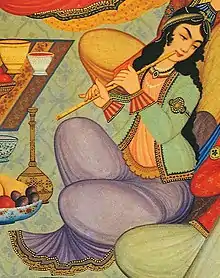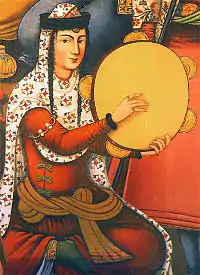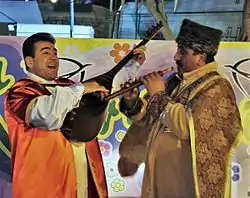Mugni
The mugni (archlute) is a Persian stringed musical instrument which resembles a tar except that the two globes are connected and not separated like the tar's.[1]
During Ghuri rulers and Khwarizmi (12th – 13th century) music grew. Two notable theorists of this era were Fakhr al-Din al-Razi and Nasir al-Din al-Tusi. Another Persian theorist was Qutb al-Din al-Shirazi who was famous for Pearl of Crown (Durrat al-taj). In the Treasure-House of Gift (Kanz al -Tahaf) an important work in 1350, ud (lute), rubab (lute), mughni (archlute), chang (harp), nuzhe, qanun (psaltery), Ghaychak (spiked viol), pisha (fife) and nay-i siyah (reedpipe) are completely described. In other places, dutar (two strings) and setar (three strings) exquisite of poet Hafez are mentioned.[2]
See also
Notes
- "Archived copy". Archived from the original on 2012-04-09. Retrieved 2011-10-01.CS1 maint: archived copy as title (link)
- https://shahnameh.netlify.com/mugni.htm The Shahnameh Guide To The Lutes Of Central Asia
.jpg.webp)



